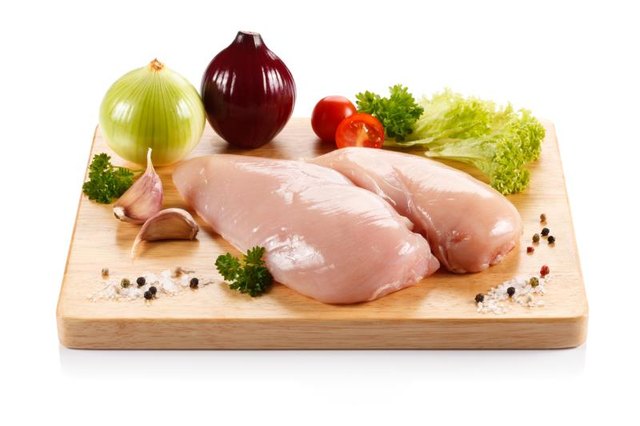
You've probably heard the saying, "breakfast is the most important meal of the day," but when you're trying to lose weight, what you eat for dinner is important, too. A healthy dinner can make the difference between shedding pounds and feeling satisfied during the evening, or overeating, gaining weight and feeling sluggish at night. You should focus on a few key nutrients when planning healthy dinners, but leave lots of room for variety in your dinner menus so you won't get bored.
Start with Vegetables
It's a good idea to eat vegetables throughout the day when you're trying to lose weight, and dinner is no exception. You need between 2 and 3 cups of veggies daily according to USDA guidelines -- depending on your age and gender -- and should plan on including at least a cup of veggies at dinner. That could mean serving a hearty soup loaded with carrots, celery and onions; a stir-fry packed with bell peppers, mushrooms and broccoli; a hearty salad made with leafy greens, like kale; or a serving of steamed veggies, like broccoli and cauliflower. The USDA recommends including a variety of veggies in your meal plan, so try to include at least two different-colored vegetables -- for example, one leafy green and one orange or red veggie -- into your dinner.
Add Lean Protein to Lose Weight
Let protein take center stage during dinner to lose weight. Swapping out starchy foods, like potatoes, for healthy proteins may help you shed pounds, according to research performed at Tufts University. The study researchers also found that choosing healthy sources of protein -- like chicken, seafood and nuts -- is linked to better weight management over time, compared to less healthy protein sources like red meat and processed meats.
Keep your proteins diet-friendly by choosing cooking methods that don't require adding extra fat. Try grilling, poaching or steaming skinless chicken breast or salmon, or saute chunks of chicken in a little chicken broth for added flavor. If you're vegetarian, up your protein intake with homemade almond and mushroom burgers, or try low-fat tofu or tempeh. Slices of tempeh work well in homemade tacos or burritos, while tofu adds protein to stir-fries. Bread sticks of tofu in a mixture of almond meal and cayenne pepper, and bake for high-protein faux "chicken fingers."
Keep your proteins diet-friendly by choosing cooking methods that don't require adding extra fat. Try grilling, poaching or steaming skinless chicken breast or salmon, or saute chunks of chicken in a little chicken broth for added flavor. If you're vegetarian, up your protein intake with homemade almond and mushroom burgers, or try low-fat tofu or tempeh. Slices of tempeh work well in homemade tacos or burritos, while tofu adds protein to stir-fries. Bread sticks of tofu in a mixture of almond meal and cayenne pepper, and bake for high-protein faux "chicken fingers."
Eat Whole Grains for Fiber
Healthy carbohydrates provide long-lasting energy and help regulate your blood sugar, so you'll feel less tempted to grab a less-than-healthy midnight snack. That's due to whole grains' high fiber content, which keeps food in your stomach for longer after your meal, prolonging that "full" feeling.
The key with carbs is portion control, since many starchy foods are high in calories. Try serving your veggies and lean protein with a half-cup serving of brown rice, quinoa or amaranth for a boost of healthy carbs, and top your grains with a squeeze of lemon juice for more flavor. Pair a hearty dinner soup with a slice of 100 percent whole-grain bread, or use a whole-grain tortilla for filling dinner tacos or burritos. If you're making stir-fry for dinner, serve your meal atop a small bed of brown rice for extra energy.
The key with carbs is portion control, since many starchy foods are high in calories. Try serving your veggies and lean protein with a half-cup serving of brown rice, quinoa or amaranth for a boost of healthy carbs, and top your grains with a squeeze of lemon juice for more flavor. Pair a hearty dinner soup with a slice of 100 percent whole-grain bread, or use a whole-grain tortilla for filling dinner tacos or burritos. If you're making stir-fry for dinner, serve your meal atop a small bed of brown rice for extra energy.
What to Eat for Dinner: Get Creative
Weight loss-friendly dinners don't have to be boring -- in fact, it's better not to fall into a rut of eating the same dinner each night; you want your new diet to be sustainable for the rest of your life. Experiment with diet-friendly substitutes for comfort food classics. For example, try mixing spiralized zucchini noodles into real whole-grain spaghetti so you can eat a larger portion without overeating carbohydrates. Finely chop cauliflower in your blender or food processor for low-carb "rice" that you can use as a rice substitute, or mix with real rice to enjoy a larger portion size. Make diet-friendly meatballs with ground turkey breast, onions, finely chopped carrots and poultry seasoning, or roll a mixture of mushrooms, brown rice and lean ground chicken breast in kale leaves for a healthful twist on cabbage rolls.
Once you've found four or five recipes that you enjoy, freeze individual portions that you can thaw on busy nights when you don't have time to cook, so you're less tempted to hit the drive-thru and overeat.
Once you've found four or five recipes that you enjoy, freeze individual portions that you can thaw on busy nights when you don't have time to cook, so you're less tempted to hit the drive-thru and overeat.
www.livestrong.com





No comments:
Post a Comment